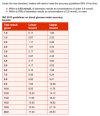Beancounter298
Active Member
- Relationship to Diabetes
- Type 2
- Pronouns
- She/Her
My fingerpick test first thing this morning was 4.9. I didn't have breakfast and had a very low carb lunch of cheese and yogurt. Just did another test prior to evening meal and the reading is 8.8. How can it have gone up so much when I've eaten only around 15g of carbs so far, and walked just under 9,000 steps? Is it possible that I should have eaten more carbs? My evening meal will be more carb heavy

